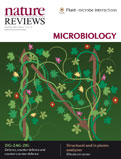Advertisement |
 |
| Microsart AMP Mycoplasma Rapid methods for the detection of mycoplasma contamination, a major risk associated with cell culture derived products, are essential for improving monitoring of the production process of biologicals. Microsart AMP Mycoplasma enables reliable and sensitive detection of mycoplasma DNA in just a few hours. Learn more. |  | | |
 |
 |
| |
TABLE OF CONTENTS
|
 |
| |
| November 2013 Volume 11 Number 11 | Advertisement
|
| Impact Factor 22.49 * | In this issue
  Editorial Editorial
  Research Highlights Research Highlights
  News and Analysis News and Analysis
  Focus on: Plant–microbe interactions Focus on: Plant–microbe interactions
| 
Don't work harder than you have to!
If you're still extracting nucleic acids for microbial research, it's time to let ATCC do the work. ATCC offers high-quality nucleic acids from hundreds of bacterial, fungal, viral, and protozoan strains, saving you the time and expense of isolating nucleic acids yourself. Don't work harder - work smarter with ATCC nucleic acids. | | |
|
|
 |
| Advertisement |
 |
| |
 |
| |
 |
| |
EDITORIAL
| Top |
 Two branches intertwined Two branches intertwined
p737 | doi:10.1038/nrmicro3152
This Focus issue on plant–microbe interactions showcases advances in our understanding of the intricate relationships between plants and their microbial friends and foes.
Abstract | Full Text | PDF
|
|
 |
 |
| |
NEWS AND ANALYSIS
| Top |
GENOME WATCH
 Cereal killers Cereal killers
Thomas D. Otto & Adam J. Reid
p744 | doi:10.1038/nrmicro3144
This month's Genome Watch traces the evolutionary history of powdery mildew and highlights the 'arms race' of this fungal pathogen with its wheat and barley hosts.
PDF
|
|
 Focus on: Plant–microbe interactions Focus on: Plant–microbe interactions | REVIEWS
| Top | RNA silencing suppression by plant pathogens: defence, counter-defence and counter-counter-defence
Nathan Pumplin & Olivier Voinnet
p745 | doi:10.1038/nrmicro3120
In plants, RNA silencing targets viral RNA for degradation, and viruses have evolved mechanisms to avoid silencing, most notably by expressing silencing suppressors. The recent identification of silencing suppressors in plant pathogenic bacteria and oomycetes suggests that RNA silencing functions in plant defence against a broad range of pathogens, not just viruses. There is also increasing evidence that plants have evolved counter-counter-defence responses to pathogen-mediated RNA-silencing suppression.
Abstract | Full Text | PDF
| On the front line: structural insights into plant–pathogen interactions
Lennart Wirthmueller, Abbas Maqbool & Mark J. Banfield
p761 | doi:10.1038/nrmicro3118
Structural biology studies of proteins involved in plant pathogen–host interactions are crucial to understanding the molecular mechanisms of both pathogen virulence and host defence. Banfield and colleagues review the current developments in the structural biology of plant–pathogen interactions, highlighting examples in which structural studies have had the biggest effect on our understanding of molecular function.
Abstract | Full Text | PDF
| Geminiviruses: masters at redirecting and reprogramming plant processes
Linda Hanley-Bowdoin, Eduardo R. Bejarano, Dominique Robertson & Shahid Mansoor
p777 | doi:10.1038/nrmicro3117
Geminiviruses are important plant pathogens that cause devastating crop losses worldwide. Here, Hanley-Bowdoin and colleagues review how viral proteins interact with cellular machineries and reprogramme cellular control pathways in their plant host to support viral DNA replication, gene expression and trafficking, and to interfere with host defences.
Abstract | Full Text | PDF | Supplementary information
| Going back to the roots: the microbial ecology of the rhizosphere
Laurent Philippot, Jos M. Raaijmakers, Philippe Lemanceau & Wim H. van der Putten
p789 | doi:10.1038/nrmicro3109
The rhizosphere – the interface between plant roots and soil – is an intriguingly complex and dynamic niche. Laurent Philippot and colleagues review recent progress in rhizosphere research and suggest that going back to the roots could be crucial to further improve the sustainability of crop production.
Abstract | Full Text | PDF
| Filamentous plant pathogen effectors in action
Martha C. Giraldo & Barbara Valent
p800 | doi:10.1038/nrmicro3119
Giraldo and Valent review the latest research into the molecular and cellular biology of the effectors that are secreted during biotrophic invasion of plant cells by eukaryotic filamentous pathogens, with an emphasis on results obtained by live-cell imaging of effector dynamics during natural plant invasions.
Abstract | Full Text | PDF
|
|
|
Corrigendum: Looking under the skin: the first steps in malarial infection and immunity
Robert Ménard, Joana Tavares, Ian Cockburn, Miles Markus, Fidel Zavala & Rogerio
p814 | doi:10.1038/nrmicro3149
Full Text | PDF
|
Corrigendum: Phenol-soluble modulins and staphylococcal infection
Andreas Peschel & Michael Otto
p814 | doi:10.1038/nrmicro3151
Full Text | PDF
|
|
|
| Advertisement |
 |
| |
 |
| |
 |  |  |  |  |  | Natureevents is a fully searchable, multi-disciplinary database designed to maximise exposure for events organisers. The contents of the Natureevents Directory are now live. The digital version is available here.
Find the latest scientific conferences, courses, meetings and symposia on natureevents.com. For event advertising opportunities across the Nature Publishing Group portfolio please contact natureevents@nature.com |  |  |  |  |  |
|











No comments:
Post a Comment